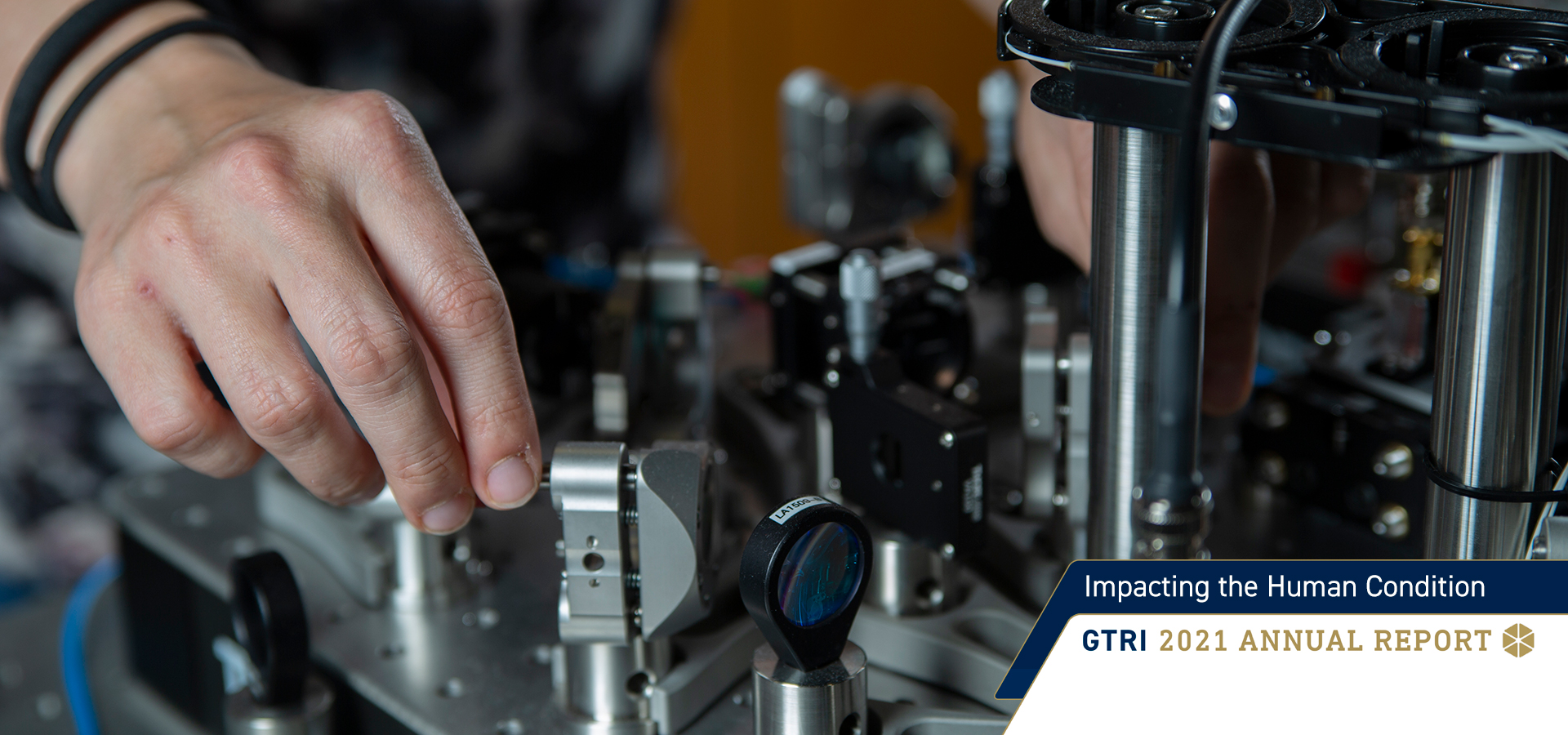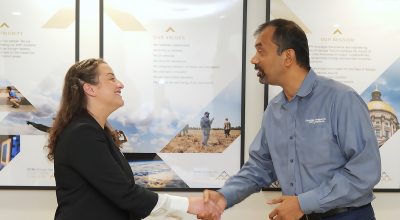
Trapped ions excited with a laser beam can be used to create entangled qubits in quantum information systems, but addressing several stationary pairs of ions in a trap requires multiple optical switches and complex controls. Now, scientists at the Georgia Tech Research Institute (GTRI) have demonstrated the feasibility of a new approach that moves trapped ion pairs through a single laser beam, potentially reducing power requirements and simplifying the system.
In a paper accepted for publication in the journal Physical Review Letters, the researchers describe implementing two-qubit entangling gates by moving calcium ions held in a surface electrode trap through a stationary bichromatic optical beam. Maintaining a constant Doppler shift during the ion movement required precise control of the timing.
“We’ve shown that ion transport is an interesting tool that can be applied in unique ways to produce an entangled state using fine control over the ion transport,” said Holly Tinkey, a GTRI research scientist who led the study. “Most ion trap experiments have some control over the motion of the ions, so what we have shown is that we can potentially integrate that existing transport into quantum logic operations.”
Measurements showed that the entangled quantum state of the two qubits transported through the optical beam had a fidelity comparable to entangled states produced by stationary gates performed in the same trapping system. The experiment used an optical qubit transition between an electronic ground state and a metastable state of 40Ca+ ions within a surface trap, a setup which allowed both one-qubit and two-qubit gates to be performed using a single beam.
The researchers moved the pair of trapped ions by precisely varying the electrical confinement fields in the trap by controlling the voltages applied to adjacent electrodes. The ions themselves have an electrical charge, a property which makes them subject to the changing electrical fields around them.
“We perform some interactions where the ions are trapped together in a single potential well and where they are very close and can interact, but then we sometimes want to separate them to do something distinct to one ion that we don’t want to do to the other ion,” Tinkey explained.
Transport operations are used in most ion trap experiments to enable loading, individual detection and individual addressing. Advances in trap design and electrical potential control have led to improvements in activities such as fast shuttling, fast ion separation, optical phase control, junction transport and ion chain rotation.
Trapped ions are among the potential platforms being studied for quantum information systems. Other options, such as superconducting qubits, are physically attached to a substrate and would not be amenable to the transport approach used by the GTRI researchers. Quantum computing techniques could help accelerate the discovery of new pharmaceuticals and create advances in materials engineering.
Gating ions via transport had been proposed theoretically a number of years ago, and another experimental group has already created interactions by moving single ions through a stationary beam. The GTRI study is believed to be the first to create a transport-enabled entangling gate with two trapped ions. In their experiment, the GTRI researchers used two tones of red light at slightly different frequencies.
Moving the ions into a single beam has at least three potential advantages. For one, if a single beam can be reflected back and forth across a trap, that one beam could interact with many ions, reducing the need for multiple beams and the power – and control complexity – they require.
“This really opens up the possibility of sharing the light among multiple sites within a larger structure, without having to have an optical switch for every pair of ions,” said Kenton Brown, a GTRI senior research scientist who collaborated on the project. “This technique allows us to literally move the ions physically out of the beam and only leave those ions we want to gate in the beam.”
Another advantage is that the intensity of the interaction can be controlled by the movement of ions through the beam rather than by adjusting the laser pulses. And because the beam intensity smoothly rises and falls as the ions move through different portions of it, problems of off-resonant coupling can be reduced, Tinkey said.
“It basically makes your curves flatter and easier to work with,” she said. “That means you could operate your gate at a larger range of de-tunings.”
But there are also disadvantages. Because the ions move through the beam, they don’t remain in the most intense portion of it for long, but are exposed to power that ramps up and down as they move. That means a more intense beam must be used to provide a specific amount of power to the ions.
Brown said that quantum researchers had been concerned that moving the ions and using their motion to create two-qubit gates simultaneously would create too many complicating factors that might make the whole approach infeasible. “But it turns out that if you have enough control of those two things, you can make it work,” he added.
Possible next steps could include extending the transport gate technique to longer ion strings with different transport modes and different ion species. The researchers would also like to use a different laser beam configuration that might further reduce the small error rate they saw in their experiments.
This research was sponsored by the Army Research Office under Grant Number W911NF-18-1-0166. The views and conclusions contained in this document are those of the authors and should not be interpreted as representing official policies, either expressed or implied, of the Army Research Office or the U.S. Government.
Writer: John Toon
GTRI Communications
Georgia Tech Research Institute
Atlanta, Georgia USA
![]()
RETURN TO 2021 ANNUAL REPORT HOME
The Georgia Tech Research Institute (GTRI) is the nonprofit, applied research division of the Georgia Institute of Technology (Georgia Tech). Founded in 1934 as the Engineering Experiment Station, GTRI has grown to more than 2,800 employees supporting eight laboratories in over 20 locations around the country and performing more than $700 million of problem-solving research annually for government and industry. GTRI's renowned researchers combine science, engineering, economics, policy, and technical expertise to solve complex problems for the U.S. federal government, state, and industry.
Learn more at www.gtri.gatech.edu and follow us on LinkedIn, Twitter, Facebook, and Instagram.



